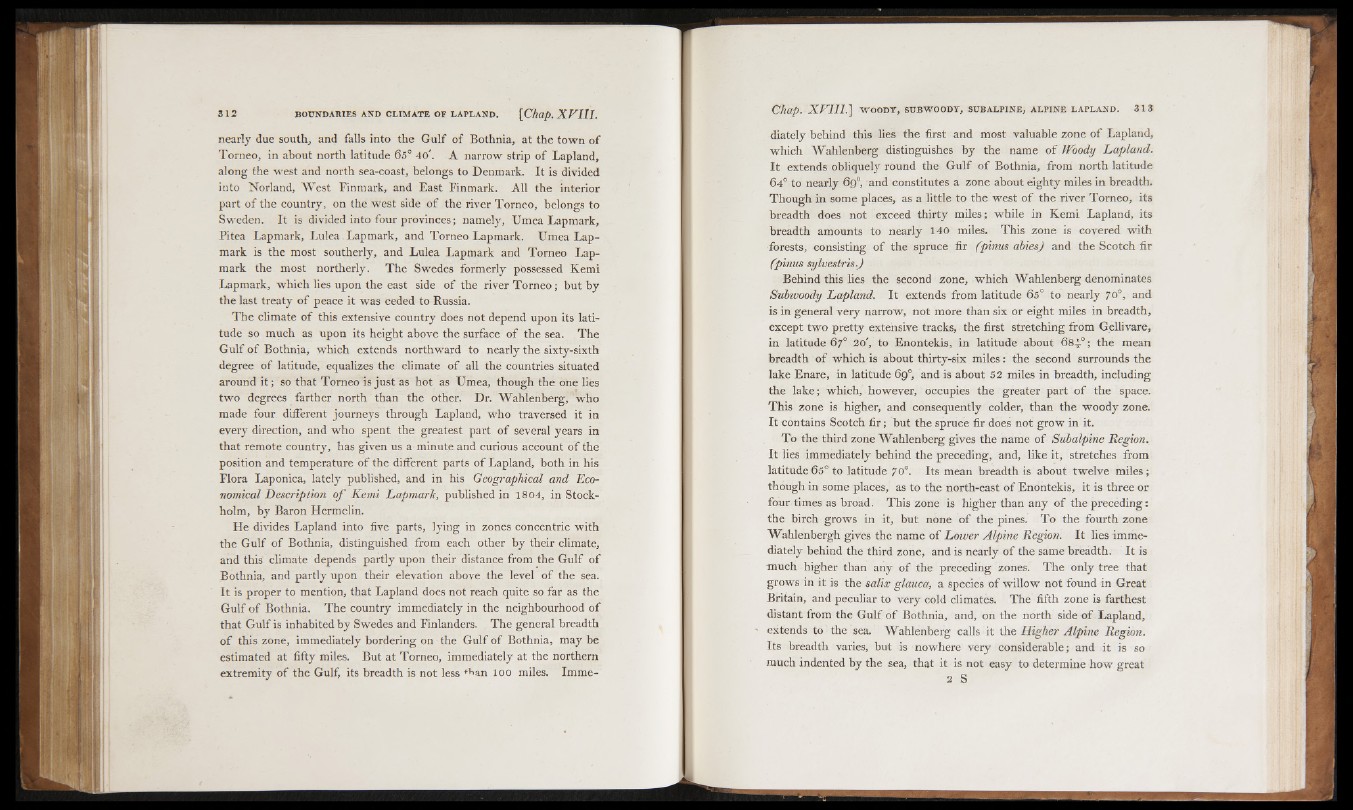
nearly due south, and falls into the Gulf of Bothnia, at the town of
Torneo, in about north latitude 65° 40'. A narrow strip o f Lapland,
along the west and north sea-coast, belongs to Denmark. It is divided
into Norland, West Finmark, and East Finmark. All the interior
part of the country, on the west side of the river Torneo, belongs to
Sweden. It is divided into four provinces; namely, Umea Lapmark,
Pitea Lapmark, Lulea. Lapmark, and Torneo Lapmark. Umea Lapmark
is the most southerly, and Lulea Lapmark and Torneo Lapmark
the most northerly. The Swedes formerly possessed Kemi
Lapmark, which lies upon the east side of the river Torneo; but by
the last treaty of peace it was ceded to Russia.
The climate o f this extensive country does not depend upon its latitude
so much as upon its height above the surface of the sea. The
Gulf o f Bothnia, which extends northward to nearly the sixty-sixth
degree of latitude, equalizes the climate of all the countries situated
around i t ; so that Torneo is just as hot as Umea, though the one lies
two degrees farther north than the other. Dr. Wahlenberg, ’who
made four different journeys through Lapland, who traversed it in
every direction, and who spent the greatest part of several years in
that remote country, has given us a minute and curious account of the
position and temperature of the different parts of Lapland, both in his
Flora Laponica, lately published, and in his Geographical and Economical
Description o f Kemi Lapmarlc, published in 1804, in Stockholm,
by Baron Hermelin.
He divides Lapland into five parts, lying in zones concentric with
the Gulf o f Bothnia, distinguished from each other by their climate,
and this climate depends partly upon their distance from the Gulf of
Bothnia, and partly upon their elevation above the level of the sea.
It is proper to mention, that Lapland does not reach quite so far as the
Gulf o f Bothnia. The country immediately in the neighbourhood of
that Gulf is inhabited by Swedes and Finlanders. The general breadth
o f this zone, immediately bordering on the Gulf of Bothnia, may be
estimated at fifty miles. But at Torneo, immediately at the northern
extremity o f the Gulf, its breadth is not less 'yu! 100 miles. Immediately
behind this lies the first and most valuable zone o f Lapland,
which Wahlenberg distinguishes by the name of Woody Lapland.
It extends obliquely round the Gulf of Bothnia, from north latitude
64° to nearly 6g°, and constitutes a zone about eighty miles in breadth.
Though in some places, as a little to the west o f the river Torneo, its
breadth does not exceed thirty miles; while in Kemi Lapland, its
breadth amounts to nearly 140 miles. This zone is covered with
forests, consisting of the spruce fir (pinus abiesj and the Scotch fir
(pinus sylvestris.J
Behind this lies the second zone, which Wahlenberg denominates
Subwoody Lapland. It extends from latitude 65° to nearly 70°, and
is in general very narrow, not more than six or eight miles in breadth,
except two pretty extensive tracks, the first stretching from Gellivare,
in latitude 67° 20', to Enontekis, in latitude about 684°; the mean
breadth of which is about thirty-six miles: the second surrounds the
lake Enare, in latitude 69°, and is about 52 miles in breadth, including
the lake; which, however, occupies the greater part of the space.
This zone is higher, and consequently colder, than the woody zone.
It contains Scotch fir; but the spruce fir does not grow in it.
To the third zone Wahlenberg gives the name o f Subalpine Region.
It lies immediately behind the preceding, and, like it, stretches from
latitude 65° to latitude 70°. Its mean breadth is about twelve miles;
though in some places, as to the north-east of Enontekis, it is three or
four times as broad. This zone is higher than any of the preceding:
the birch grows in it, but none o f the pines. To the fourth zone
Wahlenbergh gives the name of Lower Alpine Region. It lies immediately
behind the third zone, and is nearly of the same breadth. It is
much higher than any o f the preceding zones. The only tree that
grows in it is the salix glauca, a species of willow not found in Great
Britain, and peculiar to very cold climates. The fifth zone is farthest
distant from the Gulf of Bothnia, and, on the north side o f Lapland,
extends to the sea. Wahlenberg calls it the Higher Alpine Region.
Its breadth varies, but is nowhere very considerable; and it is so
much indented by the sea, that it is not easy to determine how great
2 S